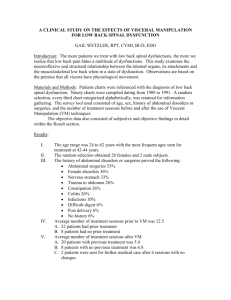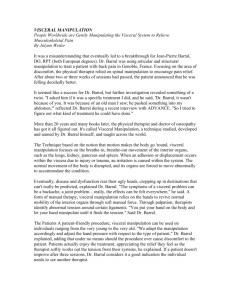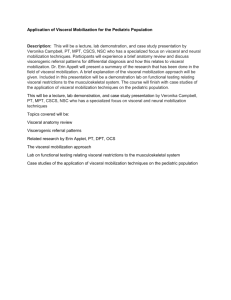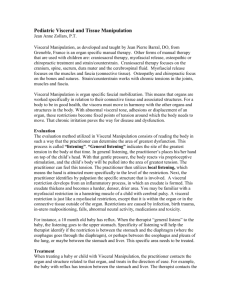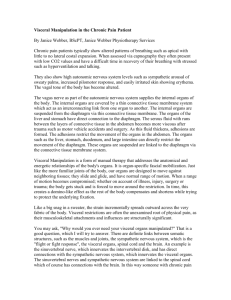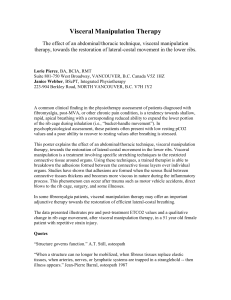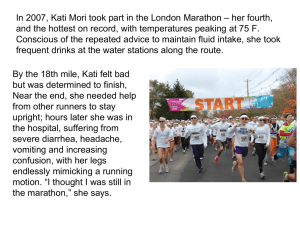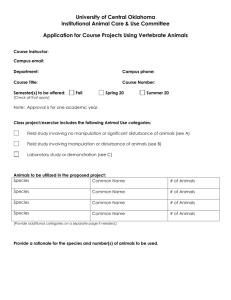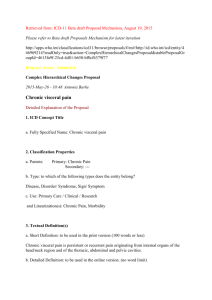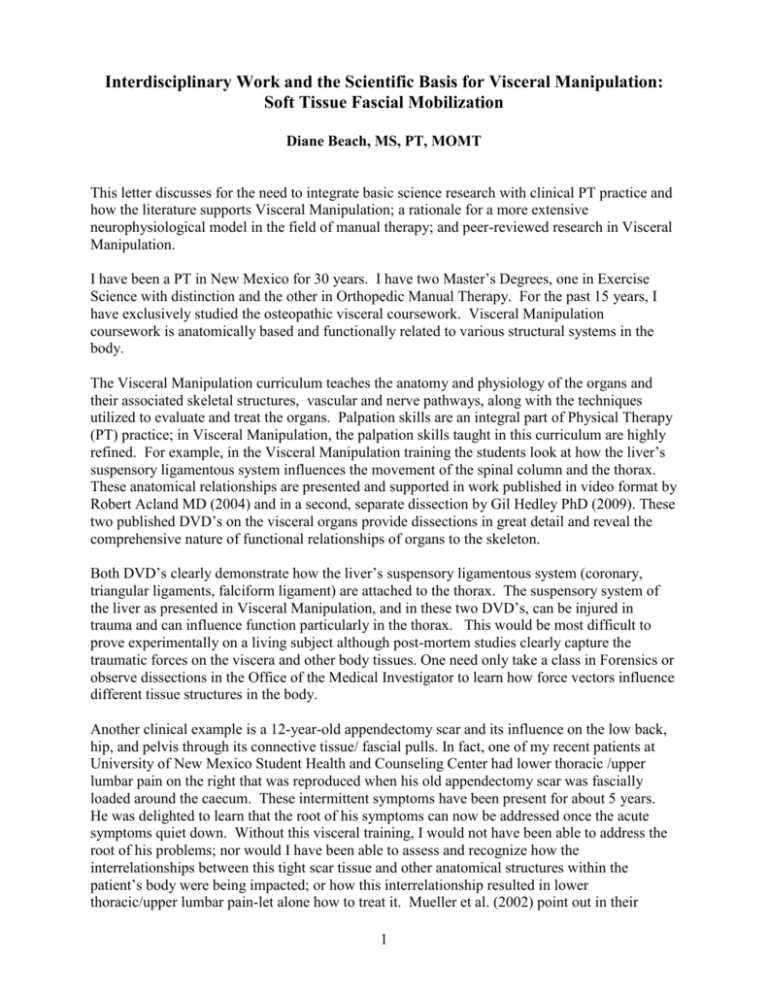
Interdisciplinary Work and the Scientific Basis for Visceral Manipulation:
Soft Tissue Fascial Mobilization
Diane Beach, MS, PT, MOMT
This letter discusses for the need to integrate basic science research with clinical PT practice and
how the literature supports Visceral Manipulation; a rationale for a more extensive
neurophysiological model in the field of manual therapy; and peer-reviewed research in Visceral
Manipulation.
I have been a PT in New Mexico for 30 years. I have two Master’s Degrees, one in Exercise
Science with distinction and the other in Orthopedic Manual Therapy. For the past 15 years, I
have exclusively studied the osteopathic visceral coursework. Visceral Manipulation
coursework is anatomically based and functionally related to various structural systems in the
body.
The Visceral Manipulation curriculum teaches the anatomy and physiology of the organs and
their associated skeletal structures, vascular and nerve pathways, along with the techniques
utilized to evaluate and treat the organs. Palpation skills are an integral part of Physical Therapy
(PT) practice; in Visceral Manipulation, the palpation skills taught in this curriculum are highly
refined. For example, in the Visceral Manipulation training the students look at how the liver’s
suspensory ligamentous system influences the movement of the spinal column and the thorax.
These anatomical relationships are presented and supported in work published in video format by
Robert Acland MD (2004) and in a second, separate dissection by Gil Hedley PhD (2009). These
two published DVD’s on the visceral organs provide dissections in great detail and reveal the
comprehensive nature of functional relationships of organs to the skeleton.
Both DVD’s clearly demonstrate how the liver’s suspensory ligamentous system (coronary,
triangular ligaments, falciform ligament) are attached to the thorax. The suspensory system of
the liver as presented in Visceral Manipulation, and in these two DVD’s, can be injured in
trauma and can influence function particularly in the thorax. This would be most difficult to
prove experimentally on a living subject although post-mortem studies clearly capture the
traumatic forces on the viscera and other body tissues. One need only take a class in Forensics or
observe dissections in the Office of the Medical Investigator to learn how force vectors influence
different tissue structures in the body.
Another clinical example is a 12-year-old appendectomy scar and its influence on the low back,
hip, and pelvis through its connective tissue/ fascial pulls. In fact, one of my recent patients at
University of New Mexico Student Health and Counseling Center had lower thoracic /upper
lumbar pain on the right that was reproduced when his old appendectomy scar was fascially
loaded around the caecum. These intermittent symptoms have been present for about 5 years.
He was delighted to learn that the root of his symptoms can now be addressed once the acute
symptoms quiet down. Without this visceral training, I would not have been able to address the
root of his problems; nor would I have been able to assess and recognize how the
interrelationships between this tight scar tissue and other anatomical structures within the
patient’s body were being impacted; or how this interrelationship resulted in lower
thoracic/upper lumbar pain-let alone how to treat it. Mueller et al. (2002) point out in their
1
article on Physical Stress Theory that physical stresses cause a predictable adaptive response in
biological tissue. In the above example, my hypothesis was the lower thoracic/upper lumbar
paraspinals had exceeded their adaptive responses in relationship to the tight fascial tensions
around the appendectomy scar.
Cooper (1979) states a” loss of intra-abdominal fat and flaccidity of the abdominal wall result in
ptosis (lowering) of the movable abdominal viscera, with tension on peritoneal and fascial
attachments”. For example, a tensional pattern around the fascial envelope of a kidney on one
side can change the dynamics of the torso being pulled to the effected side (Schwind 2006). This
could be the case from a fall on the back with a rotation at the time of impact. It could also occur
in a multitude of other situations, one being chronic inflammation in the region of the kidney,
ureter or bladder.
Clinical practice disciplines like Physical Therapy have always drawn knowledge and
application from other disciplines: Anatomy, Physiology, Neurology, Neurodevelopment,
Orthopedics, Biomechanics, Physics, Social Sciences, etc. Physical Therapy has never been
insular or exclusive in its vision, research efforts, or its practice paradigm. Earlier research
analyzed the systems of the body compartmentally; but as noted above, the results of recent
research across disciplines has recognized the need to implement a more complex, integrated
approach to clinical practice. This is, in part, the emphasis for the growing holistic,
complementary, and alternative medicine movement. A movement that continues to rapidly
grow as measured by patient visits and dollars spent for care (Eisenberg, 1993). Dollars spent
even when they are not reimbursed by health insurance but come out of the patient’s pocket.
The National Institutes of Health (NIH) have recognized the need for interdisciplinary health
research and have directed funding towards interdisciplinary rather than narrowly focused
individual disciplinary work. Indeed, like every other major Health Sciences Research Center in
the country; the University of New Mexico Health Sciences Center recently submitted a revised
proposal for an interdisciplinary, translational (bench to bedside or basic science to clinical
application and treatment) research center. This was done because of new federal funding
requirements emphasizing these areas. New funding guidelines have eliminated federal funding
for the old style, compartmentalized clinical research centers such as the one that had existed at
the University of New Mexico Health Sciences Center and required Health Science Centers who
wanted to obtain NIH center funding to submit new grant proposals emphasizing and
demonstrating interdisciplinary and translational research as part of their core mission.
The scientific basis for Visceral Manipulation work by Jean-Pierre Barral, DO, RPT is drawn
from research in multiple biological and health care disciplines. The changing nature of the
biological sciences and clinical practices in fields such as Medicine and Physical Therapy has
been dramatic in the 30 years I have practiced, with an increasing emphasis on multi-discipline
approaches to clinical knowledge and clinical practice. Recent advances in related sciences are
now making it necessary to look across disciplines for some of the answers to our questions
regarding the manual therapy’s mechanisms of action.
Khalsa et al. (2006) in their editorial review state that research and practice need to draw on
different areas of science (neuroscience, biomechanics, endocrinology, imaging, and
immunology) to answer questions regarding the mechanisms of manual therapy. They point out
“the complexities of studying the manual therapies, translating research findings into clinical
practice, and that some of the most important questions will come from clinicians themselves”.
2
They also state “the value of networks of clinicians and scientists who can work together to
explore common areas”. They report that “the manual therapies may trigger a cascade of
cellular, biomechanical, neural, and/or extracellular events as the body adapts to external stress”.
Schmid et al (2008) report the need to establish a more expansive model to look at the effects of
the manual therapies, which includes the central nervous system and quite possibly the
supraspinal centers. Bialosky et al. (2008) state “the mechanical force from manual therapy
initiates a cascade of neurophysiological responses from the peripheral and central nervous
systems, which are then responsible for the clinical outcomes”.
Visceral Manipulation is soft tissue mobilization. The abdominal and thoracic organs are
enveloped in their connective tissue/fascial membranes. As soon as we manually manipulate this
visceral soft tissue, we are effecting changes locally and in surrounding areas because of their
fascial connections (Schleip, 2003).
One explanation of how manual therapy works is provided by Donald E. Ingber MD, PhD, at
Harvard Medical School (2008) who argues for the “concept of cellular mechanotransduction,
the process by which cells sense mechanical forces and transduce them into changes in
intracellular biochemistry and gene expression.” Based on a prolific, federally funded research
program over a number of years, Dr. Ingber has been studying cells on the nanometer scale. He
views “the cytoskeleton as an architectural structure that actively generates tensile forces and
distributes them to other components inside the cell”. Ingber (2006) suggests that in the living
body “the process of cellular mechanotranduction might be more a phenomena of structural
hierarchies and biological architecture than the action of any single mechanotransduction
molecule”. This has significant implications for the field of manual therapy. Ingber (2006) states
that to “seek out and study individual biological parts in isolation without considering
contributions of multiscale architecture and invisible internal forces means we will never be able
to fully understand how physical forces influence biological form and function.”
Ingber is talking in terms of a systems approach. Johnston et al. (2001) further state “systems
theory provide a thoughtful alternative to the long-held mechanistic view of structure in which
science breaks down physical components to examine and analyze their elementary aspects.
Recognizing a living structure and its functional units, this theory draws attention to analysis of
the interactions between the subdivisions and each system as a whole. Studying functional
relationships is a central theme.“
Langevin (2005) states the unspecialized connective tissue surrounds and permeates not only the
musculoskeletal system in the body but all other tissues and organs. Because of this,
unspecialized connective tissue plays a role in “integrating the function of diverse cell types
existing within each tissue (e.g. lung, intestine – Swartz et al. in Langevin 2005 pg. 261).
Moreover, the connective tissue matrix is a key participant in mechanotransduction, or
mechanisms allowing cells to perceive and interpret mechanical forces (Chiquet et al. in
Langevin, 2005 p. 261)”. Langevin (2005) states these connective tissues influence, and are
influenced by, normal and pathological function of a wide variety of organ systems although the
exact mechanism by which the connective tissues interpret and integrate mechanical information
is not yet known.
Bessou and Laporte (in Langevin, 2001, p 2280) report ”how pressure, stretch, and mechanical
stimulation could result in mechanical connective tissue deformation thus influencing the group
3 muscle afferent found in perimuscular fascia and adventitia of muscle blood vessels”. Early
3
seminal work by Gerald Cooper (1979) elaborated on the importance of the visceral ligamentous
attachments. Leon Page DO (Role of Fascia in the Maintenance of Structural Integrity, ND)
emphasizes the interrelationships of connective tissues including the visceral ligaments. Clinical
work published by Barral and Mercier (1988) supports this and states that gentle manipulation of
a visceral ligament can induce an immediate and palpable release within that ligament. Schleip
(2003) hypothesizes that these changes underneath the practitioner’s hands may be due to
alterations in the ground substance, which can alter physiological organ function in surrounding
areas.
The cellular/tensegrity research of Ingeber (2008), connective tissue research of Langevin et al.
(2001 and 2002), and the fascial research of Schleip (2003) are critical in our understanding of
connective tissue and its applications in the manual therapies. Today, the physical therapist
specializing in manual therapy must concern herself with many different systems in the body
(musculoskeletal, visceral, lymphatic, neuromuscular, connective tissue/fascial, cranial/dural,
neural, vascular, etc.) in order to acquire the skill, experience, and competence for practice.
Physical therapists currently using Visceral Manipulation in their clinical practice need to keep
pace with the research in other disciplines and utilize interdisciplinary research approaches and
develop new methodologies for research based on their clinical practice.
Wyke’s mechanoreceptor research (1980) has been instrumental in understanding the effects of
the manual therapies and in particular joint mobilization/manipulation. Schleip (2003) explains
the importance of fascial mechanoreceptors, and with manual manipulation changes can occur in
the viscosity of the ground substance and a lowering of sympathetic tonus. Schleip (2003) has
also found smooth muscle cells in fascia that appear to be involved in active fascial contractility
and have only been reported in large fascial sheets. Pacinian corpuscles are also found in the
peritoneum (Stilwell in Schleip 2003 page 15) and can be influenced by manual therapy (Schleip
2003}. Mechanoreceptors have been found in the visceral ligaments (Schleip, 2003). The “belly
(enteric) brain” (Gershon in Schleip 2003 p. 17) contains more than 100 million neurons. Many
of these sensory neurons function as mechanoreceptors.
Mid-Range Theories Relevant to Visceral Manipulation
In the past, the stress/strain curve was an important concept to be concerned with in manual
therapy (and still is important). Spinal manipulation is thought to occur within this microfailure
zone of the stress/strain curve (Threlkeld in Schleip, 2003 p. 13). Slower, soft tissue
manipulation techniques can lead to relaxation in motor units and autonomic nervous system
changes. (Schleip, 2003) Mueller and Maluf ‘s Physical Stress Theory (2002) also provides a
useful framework to approach patient care by describing and explaining factors which influence
physical stress in the tissues and how the tissues respond to the stresses.
The gate control theory of pain (Melzack and Wall, 1962,1965) has also been broadened and
expanded on the basis of recent research. Current research recognizes the fact that pain is very
complex and can have many different characteristics and origins. (Dillard et al., 2005) Patients
can have “nocioceptive pain arising from visceral organs or capsules or from obstruction of a
hollow viscus causing intermittent, poorly localized pain.” (Dillard et al., 2005, p 530) Since
pain is a costly healthcare problem and accounts for 21% of all emergency room visits and 25%
of days lost at work (Gureje et al. in Dillard et al. 2005 p 530), it is of the utmost importance that
we study its pathways, complexities and other measures for treatment.
4
Peer Reviewed Research Supporting Visceral Manipulation
Evidence based practice requires a framework for ranking research. The New York Down State
Medical Center provides one good example of this ranking among an estimated 100 different
evidence based frameworks. It is provided here because it demonstrates the hierarchy of
evidence. Clinical research is a building process with more complex clinical research built on
evidence from less complex or other kinds of work. Research within different areas of a
discipline progress and
develop at different rates. Some areas are at a point where systematic reviews are feasible while
other areas of research involve relatively small numbers of researchers because the specific area
of investigation is new; or it involves new concepts or new relationships which require case
control or case series reports in order to build enough evidence to design and conduct
randomized clinical trials. No Human Subject Review Board would permit a randomized
clinical trial without evidence from the literature to support the hypotheses driving the
experimental intervention. This sequence in development of disciplinary knowledge involves
both quantitative and qualitative research. It also holds across clinical disciplines including
Physical Therapy.
1.
2.
3.
4.
5.
6.
7.
8.
Systematic Reviews
Meta-analysis
Randomized Control Trial
Cohort Studies
Case Control Studies
Case Series/Case Reports
Ideas, Editorials, Opinions
Animal Studies
Research cannot always be conducted using randomized double blind clinical trials although this
is considered the gold standard for clinical work. Ethics, harmful side effects, new concepts
introduced to the discipline that have not been defined, developed, and fully measured; access to
participants; and issues of funding all can and do limit the type of research being done. In
addition, qualitative peer reviewed research does not utilize randomized studies. The
philosophical and methodological approach of different qualitative researchers is based on a
completely different inquiry paradigm - that of the lived experience and fieldwork based on the
individuals experiencing the situation. Ethnography, Grounded Theory, Phenomenology, and
Hermaneutics are all well established qualitative approaches with extensive peer reviewed
published articles in the literature for multiple different disciplines researching the meaning,
impact, and experience of health care should one wish to pursue them.
The point for Physical Therapy is this: qualitative research is important as well. The challenge
of attending to the process of qualitative research as both an art and science requires “ integration
and innovation often taking knowledge into new directions outside the disciplinary box”.
(Holloway et al. 2007) In the University of New Mexico Health Sciences Center there are
multiple qualitative research studies in different disciplines (nursing, OT and medicine) funded
by the National Institutes of Health.
Interdisciplinary research certainly supports manual therapy including the visceral and fascial
work. Visceral Manipulation must be included as a critical body system to evaluate, treat, and
educate our patient. Hedley (2009 DVD Viscera and their fasciae) elaborates “the rib basket is
5
defined by the peritoneal relationships and the organs move around inside the visceral spaces”.
Jean-Pierre Barral states so eloquently in the forward to Schwind’s book Fascial and Membrane
Technique (2006) “that every aspect of the organism is important and we must not neglect a
single one of its elements”. Thomas Myers articulates beautifully in the same forward in
manipulative therapy “nothing is subtracted but strain, and nothing is added but information”.
Visceral Manipulation and manual therapy are relatively new PT modalities in the United States
having been introduced here only within the past 25 years. Perhaps one of the reasons why more
clinical research is not done in this area is because to master any skill takes years of study,
practice, patience, mentorship, and persistence. The number of practitioners in the field of
manual therapy may be small in comparison to the number of therapists in other areas of
Physical Therapy; and it takes time to build clinical expertise so research and more appropriate
treatments can be offered to patients. It also takes time and established programs of research
before new paradigms for Physical Therapy are developed based on approaches like manual
therapy.
Much of the initial research and clinical work in manual and visceral therapy has been done in
Europe and the lag between European research and U.S. research for specific areas of research
and clinical treatments is not unknown. For example, lumpectomy for breast cancer was an
accepted treatment in Europe while radical mastectomy or modified radical mastectomy surgery
procedures were still the standard surgery for breast cancer in the United States. Today
lumpectomy is a standard tissue saving procedure in the United States.
Today there is increasing research interest in these areas within the United States. Interest in
fascial research with clinical applications, such as Visceral Manipulation, has increased rapidly
in recent years. As a result of the First International Fascial Congress held at Harvard Medical
School in October 2007; the conference proceedings were published to “organize relevant
information for scientists involved in the research of the body’s connective tissue matrix (fascia)
as well as professionals involved in the therapeutic manipulation of this body-wide structural
fabric”.
Jacques-Marie Michallet – Kidney Mobilization and Ultrasound thesis experimental protocol of
25 patients with various medical diagnoses, clearly demonstrated that in 23 out of 25 cases, the
kidney mobility measured before and after Visceral Manipulation via ultrasound had improved.
Outcomes were independently measured by Serge Cohen MD (radiologist) who performed the
measurements using ultrasound. This work was presented as part of a book chapter (Barral, 1989
p 227-245). In addition to the 23 cases that showed improvement in this study there were two
remaining cases where kidney mobility did not improve. Jacques-Marie Michallet (in Barral,
1989, p.245) states that there was a diagnostic error for one of the two cases that did not
improve. This patient should have been excluded from the study for not meeting sample
selection criteria. In the second case that did not show improvement, the kidney was totally
fixed in the iliac fossa. The results of this study support the author’s hypothesis that visceral
mobility is a real phenomenon and can be positively influenced by manipulation. Other reported
outcomes included the disappearance of the study patients’ presenting symptoms such as low
back, thoracolumbar, atypical knee pain, and recurrent cystitis.
Nemett, D.R. et al. (2008) clearly demonstrate significant improvements in dysfunctional
voiding in a pediatric population (N= 21) when the patients received manual physical therapy
with an osteopathic approach (MPT-OA) compared to a similar group of pediatric patients
6
receiving the standard treatment protocol. The manual physical therapy techniques utilized were
cranial, dural, visceral, vascular and lymphatic. Standard treatments included urology visits that
included medications, establishment of timed voiding and evacuation schedules, dietary
modifications, behavior modifications, pelvic floor retraining, biofeedback training, and
treatment of constipation.
Nemett, D.R. et al. (2008) concluded the improvement in dysfunctional voiding in the treatment
group who received MPT-OA was due to several factors including improvement in normal
alignment and mobility. The authors reported that the somatovisceral relationships are another
potential mechanism for improving dysfunctional voiding symptoms since these systems are
intimately connected neurologically. Treatment outcomes were measured by portable bladder
ultrasound or during a VCUG procedure. Furthermore, MPT-OA did not have any deleterious
effects and in all cases it improved postural alignment and flexibility. Nemett et al. (2008)
concluded the MPT-OA with standard-care treatments in dysfunctional voiding to have
significant improvements in short-term outcomes of the children who participated in this study.
The authors further stated “ the traditional research methodology can be successfully used to
rigorously evaluate the effectiveness of non-mainstream treatment approaches, resulting in
evidence for new clinical paradigms”. Nemett et al. support a multi-center randomized controlled
trial of MPT-OA in children with dysfunctional voiding.
A study by Wurn, B.F. et al. (2008) supports manual pelvic Physical Therapy as an adjuvant
non-invasive procedure in addition to standard gynecological procedures in treating tubal
occlusion. In their retrospective analysis of 28 infertile women, Wurn et al. (2008) used manual
palpation of the abdominopelvic region to evaluate which abdominopelvic areas demonstrated
decreased mobility. They utilized manual soft tissue techniques to access a variety of restricted
areas including visceral, myofascial, and ligamentous structures. For the visceral tissues, the
authors utilized their palpation skills to access restrictions in the peritoneum, uterine and ovarian
ligaments, and neighboring structures.
Seventeen of the 28 patients revealed unilateral or bilateral patency as empirically measured by
hysterosalpingography or natural intrauterine pregnancy post-treatment. Nine of the 17 patients
reported a subsequent natural intrauterine pregnancy.
Diamond et al. (2001) state adhesions (e.g. infections, chemical irritation, surgery, endometriosis
that disrupt the peritoneum and produce inflammation) remain a clinically relevant problem and
in nearly every compartment in the body. Barral (2007) states “abdominal scars whether surgical,
traumatic, or infectious origin, contribute to the destabilization of good visceral disposition”.
Diamond et al. (2001) report “adhesions which are prevalent in all surgical fields can lead to
impaired organ functioning, decreased fertility, bowel obstruction, difficult re-operation,
possibly pain, and extraordinary financial sequelae. Even when adhesions are lysed they still
have a propensity to reform” (Diamond et al. 2001, p.567). Kresch et al. (in Diamond et al,.
2001, p 572) state adhesions can produce pain by restricting pelvic organs or placing them under
tension. Diamond et al. (2001) conclude it is important in the future to reduce adhesions but also
to prevent adhesions.
Binnebosel et al. (2008) collected tissue specimens from 40 patients undergoing laparatomy.
Tissue samples were evaluated using cross-polarization microscopy (CPM) by 2 independent
blinded observers. The maturity range of the adhesions ranged from .5 months to 20 years with a
median of 18 months. Eighteen of the 40 patients had one, 4 out of 40 had 2 and 18 out of 40 had
7
more than 2 previous abdominal and/or pelvic surgeries. The findings revealed “even in mature
surgical adhesions the distinct cellular components as well as the extracellular matrix proteins
may reflect an interactive cross talk between adhesion and stroma derived cells as a consequence
of a permanent process of disturbed remodeling” (Binnebosel et al. 2008, p.59). Like Diamond
et al.
(2001), Herrick et al.; Liakakos et al.; Menzies et al.; and Monk et al. as cited in Binnebosel et
al., 2008, p. 59) conclude that “adhesions create a lifetime risk for the development of potentially
relevant complications as small bowel obstruction, chronic abdominal pain or female infertility”.
In another study, Johannes Mayer et al. (2007) treated 40 patients with scars and chronic pain
patterns from 2004-2007 using various treatment techniques based on a osteopathic classification
system of local, regional, or complex dysfunctions. These scars were related to accidents,
surgeries, and radiation. In severe cases, the authors found impairments in multiple body
functions, not just in the scar area.
In local dysfunctions, Johannes Mayer et al. (2007) used various myofascial treatment
approaches. In regional dysfunctions, the various somatic-somatic, somato-visceral, viscerosomatic, and viscero-visceral pathways were evaluated and treated. In complex dysfunctions,
Mayer et al. (2007) evaluated and treated myofascial chains, lymphatic congestion, visceral
connections, cranio-sacral components, shock/trauma reactions, and emotional fixations. Mayer
reports “in the treating of scars, it is important to find the hierarchy of dysfunctions - this means
localizing the most important strain in the body”. He further explains, ” to improve the situation
of complex scarring is to treat complex patterns in the body and to bring fluids into the scar
area”.
Patients received 6 total treatments. Four treatments were done within a 2-week period, one
follow-up treatment after 3 months and one after 6 months. After 6 treatments, the patient’s pain
ratings decreased, daily activities improved, and depression scores fell. Mobility of joints and
spine function also improved. Mayer et al. (2007) concluded that osteopathic scar treatment is
effective in patients with chronic pain patterns and impaired mobility. The authors also stated the
importance of demonstrating the systematic effect of osteopathic scar treatment.
Wetzler (1994) concluded in a retrospective clinical study referencing 90 charts using a
systematic chart review by selecting every third chart between 1989 and 1991 with a diagnosis of
low back spinal dysfunction that low back pain can be associated with the visceral system.
Wetzler (1994) concluded longer pain relief was noted with Visceral Manipulation than without
Visceral Manipulation when low back pain in these patients was evaluated after a 3-month
period of treatment. Chart review also indicated spinal range of motion and strength was also
positively influenced by Visceral Manipulation.
Additional peer-reviewed European research articles are available in German, French, and Polish
if needed.
Today in New Mexico there is a thriving practice in manual therapy with patients willing to pay
out-of-pocket, if necessary, for this therapy. While insurance companies reimburse New Mexico
physical therapists for this treatment, it is also a fact that uninsured patients or patients that have
used up their allotted amount of PT reimbursement can and consistently do pay out of pocket for
this specific type of manual PT. This indicates their own perspective on the clinical
8
effectiveness of manual therapy - including Visceral Manipulation: the key point is this-it works
and patients are willing to pay for it.
Learning the visceral anatomy and system of evaluation and treatment is an integral part of
musculoskeletal assessment in Physical Therapy. These Visceral Manipulation skills have added
great depth to my manual therapy skills during the past 25 years since Visceral Manipulation has
been practiced in the United States. Physical Therapists are in a unique position to offer the
visceral work based on their educational training, variety of evaluation and treatment skills, and
access to diverse patient populations.
Bibliography
Allison, M.C., Dhillon, A.P, Lewis, W.G., Pounder, R.E. Inflammatory Bowel Disease. London,
England: Mosby International Limited, 1998
Arbuckle, B.E., The Selected Writings of Beryl E. Arbuckle, DO, FACOP. Indianapolis, IN.
American Academy of Osteopathy, 1994
Ashcraft, K., Holcomb, G., Murphy, J. Pediatric Surgery- Edition 4. Philadelphia, PA: Saunders
Elsevier, 2005.
Barral JP, Croibier A . Trauma-An Osteopathic Approach. Eastland Press Inc., Seattle, WA,
1999.
Barral, Jean-Pierre. Manual Thermal Evaluation. Vista, California: Eastland Press, 2005.
Barral, Jean-Pierre. The Thorax. Vista, California: Eastland Press, 2004.
Barral, Jean-Pierre. Urogenital Manipulation. Vista, California: Eastland Press, 2006.
Barral, Jean-Pierre. Visceral Manipulation II. Vista, California: Eastland Press, 2007.
Barral, Jean-Pierre. Visceral Manipulation. Vista, California: Eastland Press, 2005.
Becker, RE. Life in Motion-The Osteopathic Vision of Rollin E Becker. Stillness Press, LLC,
1997.
Blechschmidt, Erich. The Ontogenetic Basis of Human Anatomy. Berkeley, Calif: North Atlantic
Books, 2004.
Bly, Lois. The Components of Normal Development During the First Year of Life. Chapel Hill,
NC. University of North Carolina at Chapel Hill, NC. 1981.
Carlson, Bruce M. Human Embryology and Developmental Biology. St. Louis, MO. MosbyYearBook Inc., 1994.
Cocard, Larry. Netter’s Atlas of Human Embryology. ICON Learning Systems, 2002.
Cook, Chad E. Orthopedic Manual Therapy. New Jersey: Pearson Prentice Hall, 2007
Cook, Chad E. Orthopedic Manual Therapy. New Jersey: Pearson Prentice Hall, 2007
Cook, Chad E., Hegedus, Eric J. Orthopedic Physical Examination Tests. New Jersey: Pearson
Prentice Hall, 2008
Finet, George, DO and William, Christian, DO: Treating Visceral Dysfunction: An Osteopathic
Approach to Understanding and Treating abdominal Organs; Oregon: Stillness Press, LLC, 2000
First International Fascia Research Congress Proceedings Book. (2008) Fascia Research; Basic
Science and Implications for Conventional and Complementary Healthcare; Harvard Medical
School.
Fossum, C., “Introduction to Visceral Osteopathy,” Leitfaden der Viszeralen Osteopathie,
Elsevier; Deutschland, 2005.
Fossum, C., “Neurophysiology of Visceral Integration,” Leitfaden der Viszeralen Osteopathie,
Elsevier; Deutschland, 2005.
9
Gallaudet, B. B. (1931) A Description of the Planes of Fascia of the Human Body With Special
Reference to the Fascia of the Abdomen, Pelvis and Perineum. New York, New York: Columbia
University Press.
Gray’s Anatomy – The Anatomical Basis of Medicine and Surgery, 38th Edition. (1995)
Churchill Livingston.
Greenman, Philip E. Principles of Manual Medicine Second Edition. Maryland: Williams &
Wilkins, 1996.
Grossinger, Richard. Embryogenesis. Berkeley, Calif. North Atlantic Books, 2000.
Kimani JK. (1995) Elastin and mechanoreceptor mechanisms with special reference to the
mammalian carotid sinus. Ciba Found Symp: 192: 215-236.
Kliegman, R., Behrman, R., Jenson, H., Stanton, B. Nelson. Textbook of Pediatrics – 18th
Edition. Philadelphia, PA: Saunders Elsevier, 2007.
Kuchera ML, Kuchera WA. Osteopathic Considerations in Systemic Dysfunction. Columbus,
OH: Greydon Press: 1994, p.123-47
Langebartel, David A., PhD. The Anatomical Primer. Baltimore, MD. University Park Press,
1977.
Larsen, William, PhD. Human Embryology. New York, NY. Churchill Livingstone, 2001.
Lauge-Hansen, Niels, MD. The Development and the Emnbryonic Anatomy of the Human
Gastro-Intestinal Tract. Eindhaven Denmark. Centrex Publishing Co., 1960.
Lauge-Hansen, Niels. Developmental Anomalies of the Human Gastro-Intestinal Tract, 1973.
Lederman, Eyal. The Science and Practice of Manual Therapy Second Edition. Pennsylvania:
Elsevier, 2005
Moore, Persaud. Before We Are Born: Essentials of Embryology and Birth Defects. 5th Edition.
W.B. Saunders, 1985.
Nemett DR, Fivush BA, Mathews R, Camirand N, Eldridge MA, Finney K, Gerson AC. (2008)”
A Randomized Controlled Trial of the Effectiveness of Osteopathy-Based Manual Physical
Therapy in Treating Pediatric Dysfunctional Voiding”. Journal of Pediatric Urology 4:100-106.
Netter FH, Felten DL, Jozefowicz R. Netter’s Atlas of Human Neuroscience. Teterboro, NJ, Icon
Learning Systems, 2003.
Perlemuter, L. and J. Waligora. Cahiers D’Anatomie. Vol. 1–6, 3d ed. Paris, France: Masson.
1975
Peter Wührl, DO, Germany, co-authors Thomas Hirth, DO of Germany and Jérôme Helmoortel,
DO of Belgium; Textbook for Visceral Osteopathy.
R. Ward; Foundations for Osteopathic Medicine; Lippincott Williams & Wilkins, 2002.
Scherzer, Alfred, Tscharnuter, Ingrid. Early Diagnosis and Therapy in Cerebral Palsy. Madison,
NY: Marcel Dekker, Inc. 1982.
Singer, Edward. Fasciae of the Human Body and Their Relations to the Organs TheyEnvelop.
Philadelphia: Williams and Wilkins, 1935.
Stone, Caroline A. Visceral and Obstetric Osteopathy. Pennsylvania: Elsevier, 2007
The Collected Papers of Viola M. Fryman, DO. Legacy of Osteopathy to Children. Indianapolis,
IN. American Academy of Osteopathy, 1998.
Trowbridge, Carol. Andrew Taylor Still 1828–1917. Kirksville, Missouri: The Thomas Jefferson
University Press, 1991.
William Weintraub; Tendon and Ligament Healing: A New Approach through Manual Therapy;
North Atlantic Books, 2001
10

